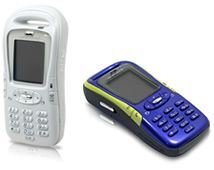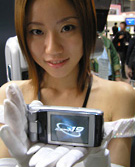Flashing Phone Accessory
Not your usual spam: “Please note attached pictures of Mobile Phone accessories; we are supplying kinsmanship item for buyer in Japan. We [just] did done 12,000,000 pcs for Japan Coca-Cola company, so, I think [these] kinds [of] accessories will find a ready market in Japan.” An interesting look at what has to be one of the most profitable businesses related to mobile phones: accessories and customization.


 Cellcos and handset manufacturers here are counting on the seemingly limitless Japanese craving to trade up to the trendiest and newest feature-packed cellies to push cash flow forward. Right behind the recent roll out of DoCoMo’s shiny, feature-packed 3G FOMA 901i-series comes a new line of four “Mova” (the carrier’s 2G brand) handsets targeting niche buyers. Lets take a look at these babies as each one has a distinctive feature targeting a specific, finicky, not-yet-ready-for-3G keitai shopper.
Cellcos and handset manufacturers here are counting on the seemingly limitless Japanese craving to trade up to the trendiest and newest feature-packed cellies to push cash flow forward. Right behind the recent roll out of DoCoMo’s shiny, feature-packed 3G FOMA 901i-series comes a new line of four “Mova” (the carrier’s 2G brand) handsets targeting niche buyers. Lets take a look at these babies as each one has a distinctive feature targeting a specific, finicky, not-yet-ready-for-3G keitai shopper. As if Japanese phones weren’t mobese enough, KDDI is first out of the gate with music distribution for cell phones — allowing multi-slackers to download artists’ songs in their entirety right to the handset. Launching this month, users of EZ Chaku Uta Full (Chaku – download, uta – song, full – in its entirety, get it?) will have access to 10,000 songs from six web sites covering everything from pop princess Hilary Duff to indie artists. Playlist and music sites are set to expand over the coming year. The company also plans to enable downloads through their ‘NOW On Air’ FM radio subscription service, though a start date has not yet been set. Content fee per song should average around 315 yen and transmission speed will hit a maximum of 2.4 Mbps under KDDI’s ‘Double Flat’ fixed packet charge service.
As if Japanese phones weren’t mobese enough, KDDI is first out of the gate with music distribution for cell phones — allowing multi-slackers to download artists’ songs in their entirety right to the handset. Launching this month, users of EZ Chaku Uta Full (Chaku – download, uta – song, full – in its entirety, get it?) will have access to 10,000 songs from six web sites covering everything from pop princess Hilary Duff to indie artists. Playlist and music sites are set to expand over the coming year. The company also plans to enable downloads through their ‘NOW On Air’ FM radio subscription service, though a start date has not yet been set. Content fee per song should average around 315 yen and transmission speed will hit a maximum of 2.4 Mbps under KDDI’s ‘Double Flat’ fixed packet charge service.